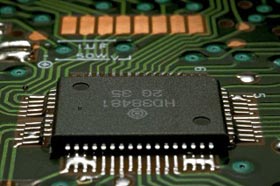-Engineering prototype boards
-Marketing demo boards
-ATE boards
-Medium volume production runs
Board level components are our specialty but we also provide top assembly parts.
|
|
 |
|
Be sure to check out our "Useful Info" for bits of practical wisdom given to engineers over the years.
|
|
|
Useful Info to read before you use that part number!
- Amp is not Amphenol and Amphenol is not Amp.
- Mica caps are a little tricky; the value marking on them is somewhat inconsistent with the other capacitor markings. A 47 pf cap has a marking of 470; the 470 pf cap will be marked with a 471.
- An "R" in a resistor code stands for the decimal point. It is to round out the four number code for a value under 100 ohms.
- Use the proper manufacturer’s nomenclature or industry part number in your BOM or library and not one from the catalog distributors. Check the OEM’s datasheets for the correct part number, as the catalog distributors can mangle the numbers. It is bad enough when OEM’s change their part number themselves, but why they allow catalog distributors to do it is a mystery. Why the distributors do it is so that their own part number gets into your documentation and hopefully no one will go back and figured out the real part number to take to a competitor. In the ECG catalog it was always easy to find their part number with the industry part number, but good luck with finding the industry part number with just their part number. They of course are the worst example.
- There are BOM’s out there with date codes for part numbers. If you are looking for a "9843" or a number with YYWW, (9702, 9523) means that someone thought that the number marked on the unit was the part number; it wasn’t of course.
- Connectors and socket manufacturers have the worst numbering systems, and they all are guilty to a certain extent of numbering their parts to make it easy for their internal manufacturing planners and not for part identification by their customers. Never use the number on a socket or connector with out going through the part number exercise in the OEM’s catalog.
- Anytime you want something that is on either edge of the parameter range, you could be looking for trouble.
- Prefixes may not be important in part identification or subbing for another part manufacturer, but the suffixes are always important. Prefixes are the marketing creativity, suffixes are the design tools. Check each manufacturer’s code as some are different than others on sizes, grade outs and temperature ratings.
- Everything (now be brave) on the internet is not available, let alone in two piece quantities off the shelf.
- When you are at a distributor or OEM website and find the component needed, make sure you check the box to see if the part is in stock.
- BNC is the acronym for Bayonet N style connector - with bayonet meaning you push in and turn.
- A good optoisolater is the HCPL2630.
- The "E" in the Aromat (NAIS) part number relays is an obsolete nomenclature, it has been dropped since 95 but it is still everywhere.
- Capacitor charts always look so robust with lots of seductive values but watch for the trap; the readily available standard values are 1.0, 1.5, 2.2, 3.3, 4.7, and 6.8 with their respective decades.
- If the surface mount capacitor is a blue color then it probably is a COG, if a SMD resistor is a green color then it probably is a 0.1% tolerance. Probably.
- Understand that all relay manufacturers will have delivery problems- it is just a matter of time and opportunity.
- Some good small-signal MOSFETs are 2N7000, VP0109N3 and TN0110N3.
- A good general purpose SCHOTTKY diode is a 5082-2811 from Agilent (old HP). This number gets mangled in various forms on BOM’s. 5082-2835 is a high conductance SCHOTTKY diode also from Agilent.
- "Bumpon" is the technical trade name for rubber feet and "shunt" is the technical name for PCB jumpers.
- "Header" is the technical name for the connector end which is soldered into the board or box, the one which is stationary.
- A 0.1% resistor in a value that is not in the standard 1% value will be more expensive and probably has a long lead time. Don’t be fooled by the chart.
- EEPROMS will go obsolete faster than fresh milk.
- The great tantalum capacitor shortage in 2000 was truly awful, something to tell the grandchildren in one’s old age.
- When deciding on a tantalum SMD watch your voltage ratings and size. If you consistently use the highest voltage for that size, you can reduce the number of capacitors in your stock. Substituting a higher voltage tantalum capacitor is perfectly fine.
- If in trouble you can use the "HCT" digital logic family for the "HC" but you can not go the other way.
- Nothing is free is physics. You can not get lots of capacitance, lots of voltage, and a COG dielectric all in a tiny package.
- Custom resistors with high precision tolerances have a high price and long delivery times. Order early.
- Good vendors for discrete small signal bipolar transistors, MOSFETs, and JFETs are Fairchild, Vishay Siliconix and Zetex. International Rectifier is a good source for high power MOSFETs and IGBTs.
- Document all designs, even little bench prototype boards. You won’t remember what you used six months from now, let alone your replacement.
- THIS IS BIG! Just because you were able to break one of these rules, DO NOT think that these rules are incorrect. Sometimes people get lucky.
|

